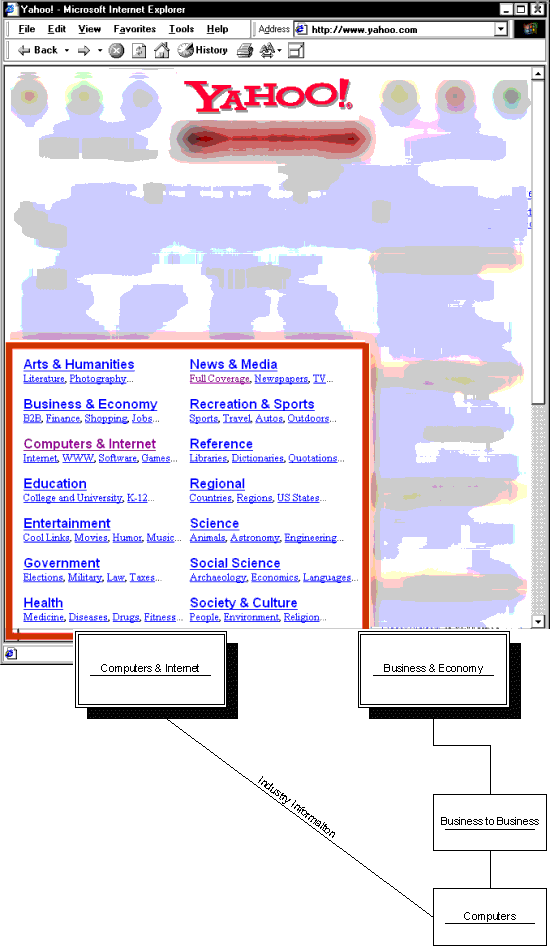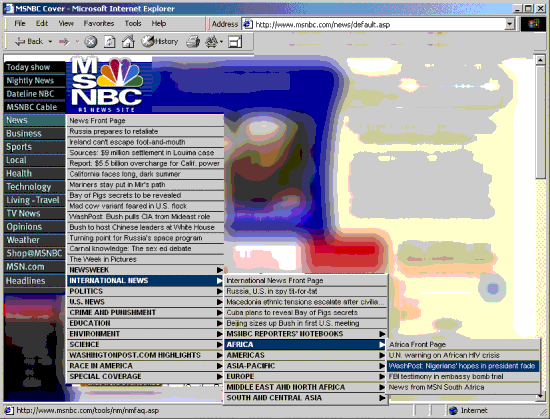In Web design, especially information architecture, it is important to understand what a hierarchy is. A well-designed hierarchy is one of the most effective navigation systems. On the other hand, a defective hierarchy can make it difficult for users to understand the website. In this article, we will discuss what a hierarchy is (and is not), some important characteristics of hierarchies, and then talk about how to create one. First, here is a somewhat formal and broad definition of a hierarchy.
A hierarchy is a system for arranging entities such that every entity has exactly one superior (except for the root entity). For example, each of these people reports to their superior and only that one superior. In addition, the CEO does not report to anyone – she is the root entity.
What a hierarchy is
The exclusive branch
The most distinctive feature of a hierarchy is the exclusive branch. Each item (except the root) is an exclusive branch of another item. In the org chart example, Ron James is a branch of Joan Randolph. But Joan Randolph is not a branch of another item becomes she is the root of the hierarchy.
Exclusive means that an item does not branch from more than one other item. It can branch to more than one item but not from more than one other item. In the org chart example, Jason Baker branches into two items; this is a proper hierarchy. On the other hand, the diagram of the Yahoo example (see below) is not a proper hierarchy; the item Computers branches from two other items.
Relationships
The two major types of relationships you can use a hierarchy to represent are rank and detail.
The best example of a rank hierarchy is the company org chart. Each item (except the root) is inferior to another item on the org chart. Rank hierarchies make it easy to visually see the relationships between different items.
When biologists give a scientific name to a species, they use a hierarchy; this is a great example of arranging a hierarchy based on detail or specificity. We divide all species (same root-word as specific) into kingdoms, phylum, orders, families, etc. Each level is more specific that the next.
Examples
A family tree example
A family tree is a hierarchy. We often call a hierarchy a tree because each item is a branch of another item, except for the root. The root of the tree is the top most level.
An outline is also a hierarchy. The top most level (root) is the title of the outline itself. The next level is the large roman numerals; each other item is inferior to one of the roman numerals. In an outline, it is easy to see how there should be very little overlap between items.
I. Introduction a) About the author b) About the book II. Beethoven's Parents a) His Father b) His Mother III. Beethoven's Early Years a) ...
You have arranged all of the files and folders on your computer into a hierarchy. Each file can only be in one folder (directory) and each folder is in only one folder. Again, we call the top most folder the root of the file system.
What a hierarchy is not
It is possible to arrange information or even navigation on a website without using a hierarchy. Arranging items chronologically, alphabetically, or by keyword are some alternatives to using a hierarchy.
Yahoo arranged their directory by keyword for example. Each major category is broken into sub-categories. At first, this appears to be a hierarchy; the difference is that the sub-categories overlap.
If you are in the category “Computers & Internet” and you click on “Industry Information,” then Yahoo takes you to the subcategory “Computers” in “Business to Business” in the category “Business & Economy.”
Just as a tree branch does not come from two different tree trunks, in a hierarchy, an item cannot have two other items superior to it.
Important aspects of hierarchies
Arbitrary
If you have ever tried to find a file on your co-workers computer, then you can understand that hierarchies are arbitrary. The task of creating an intuitive hierarchy falls to the organizer.
Hierarchies are inherently arbitrary in their definition. For example, scientists could choose to arrange species by color, size, and smell instead of the current system.
It is important to create hierarchies that use the arbitrary nature of hierarchies to their advantage. The relationships between the items should be intuitive, natural and literal whenever possible. For example, an org chart is literal because it literally represents the reporting structure of the company; it is natural in that a janitor does not usually report to a salesperson.
Exclusive
The best hierarchies are exclusive in their definition. It is easy to add new items to a well-defined hierarchy; the existing branches and their definitions are exclusive enough to make it obvious how to organize everything.
Imagine the org chart of a company that manufactures computers. If the definition of the Director of IT is broad and vague like, “the person in charge of all the computers,” then it is not clear if the engineers that design the computers should report to this position. If the definition is exclusive like “the person that implements and maintains all computers and related equipment used by the employees of this company,” then it becomes clear that those engineers should not report to the Director if IT.
Comprehensive
To be exclusive, a hierarchy must also be comprehensive; all possible branches of the root must have a definition. A species classification system that did not include turtles or birds that do not fly would be a silly system.
Start with your root item, if all items that you want in your hierarchy are related to this item, then it is likely that the hierarchy is comprehensive. If not, try to find a root item that is more broad.
Not all items fit into a hierarchy
There are times when an item should not be included directly in the hierarchy; instead, you should note the item that is related to the hierarchy, but not part of it.
For example, some companies have an employee (or department) with the title of Ombudsman. The ombudsman represents the employees’ interests in the company. If an employee has a dispute with the company, he or she contacts the ombudsman. The ombudsman investigates and acts on behalf of the employee, not the company. Since the ombudsman needs to act in the best interest of the employee, it is a conflict of interest if he or she reports to someone else in the company. Therefore, most companies wisely find some way to place the ombudsman outside of the normal hierarchy.
Using a hierarchy for web navigation
The most common type of navigation system for a website is based on a hierarchy. MSNBC has divided their articles into sections and subsections. This article called “WashPost: Nigerians’ hopes in president fade” is in the subsection called “Africa,” which is a subsection of “International News,” which is a subsection of “News.”
A properly designed hierarchy is one of the best ways to organize a website. Using the ability of a hierarchy to move from general to specific is a great way to create a navigation system.
Try to keep in mind that if you include items in your hierarchy that do not fit, then it will confuse the user; the user won’t just be confused about the few items that don’t fit, the entire hierarchy will be suspect.
How to create a hierarchy
Creating an initial hierarchy from scratch can be difficult. If you are stuck, try these ideas.
First, start by trying to write down all of the items that might be in your hierarchy. It is not important to know for sure if something will be in it or to write down every possible item.
You will find that certain relationships will be obvious. Some items are clearly superior to or related to other items. Rearrange your list by putting related items near each other and starting to physically arrange the items to represent some of the relationships your are finding.
Some traps are easy for you to fall into. Be careful not to confusing relationships like chronological and alphabetical as being hierarchical. You may try to make something superior to something else only because it happened first in a chronology.
Try to find the items that do not seem to fit. If you have many items that do not fit into your hierarchy, then you need to change your perspective. Look for relationships between the misfits and your other items. You may find some associations you did not notice before. If you still cannot find a hierarchy that includes most of your items, you may need to broaden the scope of the hierarchy.




